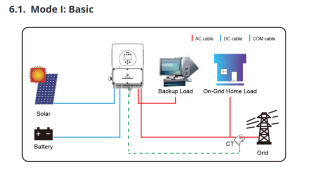I am looking to get solar panel for my house in the UK. The quotation I am likely to go for is with a 5.5kW Sunsynk inverter, 6kW panels, and 5kWh battery.
In principle I'd like to make use of backup function, to keep the "essential load" going if there is a grip power outage.
This is more of a "why not" case, for piece of mind: power outages have been very rare where I live in the past few years (to be fair, part of me also wonders if there may not be more power outages in the future, due to more renewables which vary more in production, and sad geopolitical events which threaten gas supplies... I might be overthinking though?)
Now the "essential load" is plugged on the "LOAD" port of the inverter:
1) does that mean that it would lose power if the inverter fails? if so presumably I'd have no power on those until I can get the inverter fixed, or an electrician to re-route the rings directly to the main consumer unit / grid, which could take days? Or is it clever enough to automatically get the "essential load" ports on mains in case of failure?
2) how reliable are (Sunsynk) inverters? any view on the risk of inverter failure vs. risk of grid power outage in a zone which have had very few power outages?
Thanks!
In principle I'd like to make use of backup function, to keep the "essential load" going if there is a grip power outage.
This is more of a "why not" case, for piece of mind: power outages have been very rare where I live in the past few years (to be fair, part of me also wonders if there may not be more power outages in the future, due to more renewables which vary more in production, and sad geopolitical events which threaten gas supplies... I might be overthinking though?)
Now the "essential load" is plugged on the "LOAD" port of the inverter:
1) does that mean that it would lose power if the inverter fails? if so presumably I'd have no power on those until I can get the inverter fixed, or an electrician to re-route the rings directly to the main consumer unit / grid, which could take days? Or is it clever enough to automatically get the "essential load" ports on mains in case of failure?
2) how reliable are (Sunsynk) inverters? any view on the risk of inverter failure vs. risk of grid power outage in a zone which have had very few power outages?
Thanks!





